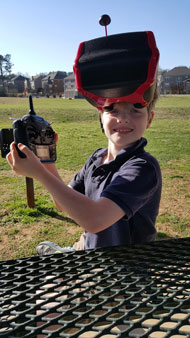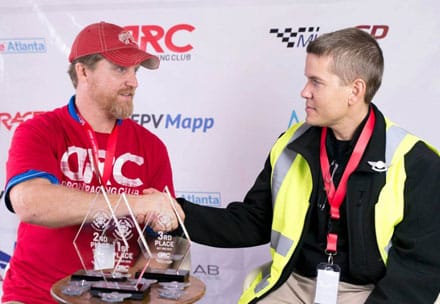
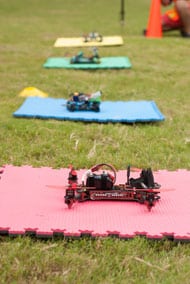
A drone is, technically, any unmanned aerial vehicle that is computer operated, remotely operated or a combination of both. A drone can be an airplane or a multi-rotor helicopter.
Right: Todd’s son Tristan Wahl getting ready to fly
“I built my first multirotor drone in 2005, before anybody even knew what they were,” Todd said. “It cost about three thousand dollars.” More than 10 years later, much of the drone technology looks the same, but there have been a few key advancements. Battery life, flight time and payload capacity have been extended. In addition, autonomous flight via computers has been developed. Around 2008, the FAA ruled against commercial use of drone technology (pending the formation of rules), because of safety concerns integrating drones into the National Air Space (NAS). “I think that made a lot of sense….I just wish the FAA had made their original deadline of 2015,” said Todd, who is all for establishing rules and regulations for this powerful technology.
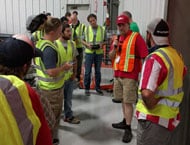
As happens with so many hobbies, sports and passions, Todd put his hobby on a back burner when his children began coming along (after 2005). The time and cost considerations were pretty high back then. “When you crash a three thousand dollar drone, that gets expensive,” he laughed. “Too expensive for a guy with four kids.”
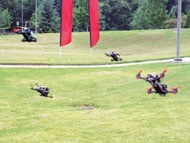
After doing a lot of travel and research toward that end, he met Doug Andriuk (founder of one of the largest Drone Users Group in the USA). “Doug told me that, as early as a couple of years ago, people were holding impromptu FPV drone races in California & Arizona. Those were park races, mostly for fun, not so much for competition,” Todd said. Still, the seed of excitement about racing drones – not just flying them for a hobby – had been planted and eventually, Todd founded Drone Racing Club, which promotes safe, responsible competition in the sport of FPV drone racing. The club has grown from about 30 members initially to hundreds in just the metro Atlanta area in about a years’ time, a testament to the attraction of this fascinating new sport.
“For years, the problem was that people were flying their drones in neighborhoods and around people, which is neither safe nor responsible. Now, we set up courses in abandoned buildings, in open fields and on sports fields. The world’s first drone relay races, complete with pit crews and pilots, were held right here in Georgia, in the Georgia Dome and the World Congress Center,” Todd said. Drones can fly 80 mph, and today most are a little larger than a man’s hand. The cost of a drone has gotten smaller, too, at $500 – $600 per aircraft. And yes, make no mistake, drone racing is a sport. Even better, it’s an inclusive sport that has broken barriers that no other sport has been able to break.

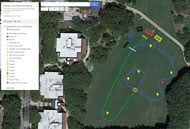
Colleges are getting in on the action, too. Not surprisingly, on April 23 Georgia Tech got on board, with the first sanctioned and funded college drone racing club in Georgia’s university system. Colleges all over the world are doing the same, and still more are sitting up and taking notice of this adrenaline-infused sport that requires training and skill. It’s an added bonus that almost anyone can participate in this inclusive, highly competitive sport.
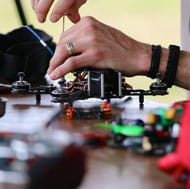
Oil, civil engineering, construction, farmers and power company executives are looking at how inspections and other tasks can be performed by drones rather than by manned aircraft. Those tasks, as well as search-and-rescue missions, can be done at perhaps a thousandth of the cost of piloted operations. And drones can often be mobilized in a matter of minutes, not hours or days. That could make all the difference in the success of an operation in which people are searching for a small child or elderly person with Alzheimer’s disease.
It’s easy to see why Todd Wahl is one of FPV Drone Racing’s most enthusiastic spokespeople out there. To learn more about Drone Racing Club, to read Todd’s blog, to become a member, or to check out exciting racing videos, visit www.1drc.com.

